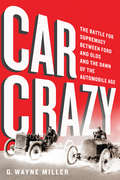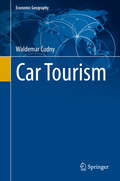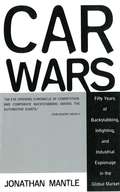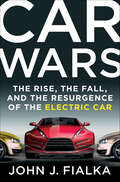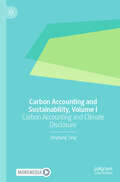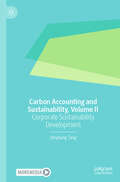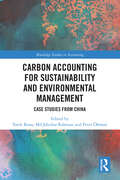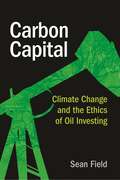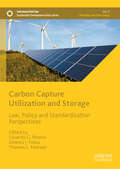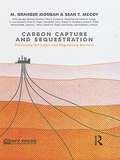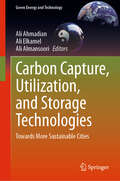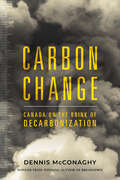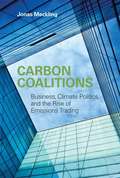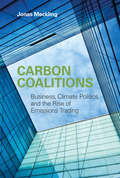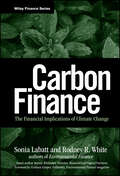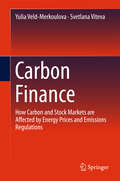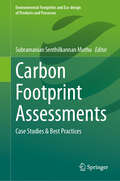- Table View
- List View
Car Crazy: The Battle for Supremacy between Ford and Olds and the Dawn of the Automobile Age
by MillerIn Car Wars, G. Wayne Miller, author of Toy Wars: The Epic Struggle Between G. I. Joe, Barbie, and the Companies That Make Them and Men and Speed: A Wild Ride through NASCAR’s Breakout Season, takes readers back to the wild and wooly years of the early automobile era--from 1893, when the first U. S. -built auto was introduced, through 1908, when General Motors was founded and Ford’s Model T went on the market. The motorcar was new, paved roads few, and devotees of this exciting and unregulated technology battled with citizens who thought the car a dangerous scourge of the wealthy which was shattering a more peaceful way of life. As the machine transformed American culture for better and worse, early corporate battles for survival and market share transform the economic landscape. Among the pioneering competitors are: Ransom E. Olds, founder of Olds Motor Works, inventor of the assembly line (Henry Ford copied him), and creator of a new company called REO; Frederic L Smith, cutthroat businessman who became CEO of Olds Motor Works after Olds was ousted in a corporate power play; William C. "Billy” Durant of Buick Motor Company (who would soon create General Motors), and genius inventor Henry Ford. The fiercest fight pits Henry Ford against Frederic Smith of Olds. Olds was the early winner in the race for dominance, but now the Olds empire is in trouble, its once-industry leading market share shrinking, its cash dwindling. Ford is just revving up. But this is Ford’s third attempt at a successful auto company--and if this one fails, quite possibly his last. So Smith fights Ford with the weapons he knows best: lawyers, blackmail, intimidation, and a vicious advertising smear campaign that ultimately backfires. Increasingly desperate, in need of dazzling PR that will help lure customers to his showrooms, Smith stages the most outrageous stunt of the era: the first car race across the continental United States, with two of his Olds cars. The race pits the dashing writer Percy Megargel, a wealthy New Yorker, against Everyman mechanic Dwight B. Huss, a sturdy Midwesterner--men who share a passion for adventure and the new machine. Covered breathlessly by the press and witnessed by thousands in the communities they pass through, Megargel and Huss encounter marvel, mishap, conflict, and danger on their wild 3,500-mile race from Manhattan to Portland, Oregon, most of it through regions lacking paved roads--or any roads at all. . . Meanwhile, the Ford/Smith battle develops in the newspapers and courtroom dramas. Its outcome will shape the American car industry for a century to come. Car Wars is a page-turning story of popular culture, business, and sport at the dawn of the twentieth century, filled with compelling, larger-than-life characters, each an American original
Car Guys vs. Bean Counters
by Bob LutzA legend in the car industry reveals the philosophy that's starting to turn General Motors around. In 2001, General Motors hired Bob Lutz out of retirement with a mandate to save the company by making great cars again. He launched a war against penny pinching, office politics, turf wars, and risk avoidance. After declaring bankruptcy during the recession of 2008, GM is back on track thanks to its embrace of Lutz's philosophy. When Lutz got into the auto business in the early sixties, CEOs knew that if you captured the public's imagination with great cars, the money would follow. The car guys held sway, and GM dominated with bold, creative leadership and iconic brands like Cadillac, Buick, Pontiac, Oldsmobile, GMC, and Chevrolet. But then GM's leadership began to put their faith in analysis, determined to eliminate the "waste" and "personality worship" of the bygone creative leaders. Management got too smart for its own good. With the bean counters firmly in charge, carmakers (and much of American industry) lost their single-minded focus on product excellence. Decline followed. Lutz's commonsense lessons (with a generous helping of fascinating anecdotes) will inspire readers at any company facing the bean counter analysis-paralysis menace. .
Car Tourism (Economic Geography)
by Waldemar CudnyThis book examines the role of cars and the space connected with their production and presentation in tourism development. It describes the role played by experiences and experience societies formed in the 20th c. in the development of contemporary tourism, including tourism related to cars. The book explores the influence of experiencing unusual events, such as car races, car fairs, visits to car industry museums or multifunctional spaces connected with producing and exhibiting cars (e. g. Autostadt or Audi Forum) on the development of a new type of tourism, i. e. car tourism. This kind of tourism is novel in two ways: firstly, it is a new phenomenon in science, as so far it has not been thoroughly studied or described, apart from various short articles. Secondly, this type of tourism has developed on a large scale only in recent years, mainly due to the huge investments made by powerful European car manufacturers (e. g. Autostadt, Audi Forums, Porsche Museum, Lamborghini Museum etc. ). The book presents cars and the spaces related to them as tourist assets (sites, events) and as tourist products that satisfy tourists' needs. Moreover, it connects the issue of car tourism to the marketing strategies of large car manufacturers and discusses the theory of tourism space, highlighting the main tourism spaces in which car tourism develops. It presents multifunctional spaces (factories, adventure centres - Autostadt in Wolfsburg), museums, car exhibitions, and race tracks. In the next chapter, following an introduction to the problem of events, the author describes events related to car tourism, including races, rallies, driving schools and car fairs. The book ends with a summarizing chapter, which includes a model of the function of car tourism as a separate type of tourism, as well as a discussion presenting the main features, advantages and disadvantages of car tourism in the context of the tourism space theory.
Car Wars: Fifty Years of Backstabbing, Infighting, And Industrial Espionage in the Global Market
by Mantle JonathanAn "astonishing...eye-opening chronicle" (Publisher's Weekly) of backstabbing, infighting, and industrial theft and espionage in the world's biggest business. It makes empires; it destroys economies; it shapes history. Welcome to the world's biggest business--the automobile industry. A hundred years ago there were six highly experimental cars. Today there are close to 400 million cars on the planet: set bumper to bumper on a six-lane highway, they would stretch well over 200,000 miles, more than eight times around the earth. With hundreds of billions of dollars at stake, is it any wonder that the major car companies wage a relentless war against one another, where (almost) anything goes? Here is the story of all the schemes and deceits, treacheries and shady deals in the battle for the world's car markets since the dawn of the global economy fifty years ago. The first true biography of the automobile, Car Wars gives us the automotive history as seen through the windshield of the car--with stories so spectacular they are often hard to believe. From Gianni Agnelli's deal to make Fiats in the USSR at the height of the cold war and Jose Ignacio Lopez's defection from GM to VW, through Pehr Gyllenhammar's foiled attempt to merge Volvo and Renault, and on to Nicolas Hayek's deal with Mercedes-Benz to build the Swatchcar in 1997, Car Wars is a roller coaster ride down the freeways and the back roads of the world's premier business, and an eye-opening history of the world's best-known and most-loved cars.
Car Wars: The Rise, the Fall, and the Resurgence of the Electric Car
by John J. FialkaDrawing from the last decade of his 26-year career at the Wall Street Journal, where he covered energy and environmental matters, ClimateWire founder and industry insider John Fialka brings to life this thrilling and important story about American's rejection and second obsession with the electric car.The resurgence of the electric car in modern life is a tale of adventurers, men and women who bucked the complete dominance of the fossil fueled car to seek something cleaner, simpler and cheaper. Award-winning former Wall Street Journal reporter John Fialka documents the early days of the electric car, from the M.I.T./Caltech race between prototypes in the summer of 1968 to the 1987 victory of the Sunraycer in the world's first race featuring solar powered cars.Thirty years later, the electric has captured the imagination and pocketbooks of American consumers. Organizations like the U.S. Department of Energy and the state of California, along with companies from the old-guard of General Motors and Toyota as well as upstart young players like Tesla Motors and Elon Musk have embraced the once-extinct technology. The electric car has steadily gained traction in the U.S. and around the world. We are watching the start of a trillion dollar, worldwide race to see who will dominate one of the biggest commercial upheavals of the 21st century.
Car Wash Partners, Inc.
by Paul A. GompersExamines the investment decision of Cabot Brown and Bill Burgin, two venture capitalists, to finance Car Wash Partners (CWP). CWP intends to purchase automatic car washes around the country. Investment strategy and deal structuring are discussed.
CarMax
by Rajiv Lal David KironCarmax is the largest multi-market used car dealer in the U.S., and has no format-to-format competitor in the $375 billion used car market. CarMax is trying to do what some analysts believed to be impossible: sell used cars profitably on a national scale, and at the same time revamp the tarnished image of the used car salesman.
CarMax Inc.: Disrupting the Used-Car Market
by John R. Wells Hong LuoCarMax, Inc.: Disrupting the Used-Car Market by John R. Wells and Hong Luo
CarMax: Disrupting the Used-Car Market
by John R. Wells Galen Danskin Hong LuoIn 2012, CarMax was the leading retailer of second hand cars in the United States and a fast-growing competitor in the used car auction market. After their founding in 1993 by Circuit City's management, CarMax had grown rapidly. They had been profitable since 2000 and independent from their parent company since 2002. While Circuit City went bankrupt in 2009 under pressure from Best Buy and challenging economic conditions, CarMax flourished and expanded through the economic crisis. Fiscal 2012 revenue reached $10.5 billion and net income, a record $413 million. However, CarMax still only accounted for less than 3% of the fragmented second hand car market. Additionally, they were keen to avoid the fate of their parent and to stay ahead of copy-cat competitors. What should CarMax do to grow its market position and continue its success in used car retailing and auctioning?
CarTrade
by Rajiv Lal Shreya RamachandranVinay Sanghi, the founder and CEO of CarTrade, had been trying different business strategies to keep the company, which he founded in 2010 as an online marketplace for used and new cars, profitable and on track for growth. In a crowded and disorganized dealer marketplace in India, and an environment where consumers had gotten used to buying online, Sanghi had found that some big challenges were getting dealers to believe the validity of digital platforms to bring in customers, and for CarTrade itself to grow, get more margins from dealers, and get more advertising revenue from car manufacturers. Sanghi came from a world of brick-and-mortar retail and his family had run car dealerships, so he had started drawing on some of that history to build a franchising model, and acquire a large offline auctioner of vehicles in India. Plans were also underway to build an NBFC to lend to dealers and consumers. Would this be enough, and were these promising strategies? What would be the way forward for CarTrade, an e-marketplace, to build its margins, solidify its customer base and steer toward growth?
Carbon Accounting and Sustainability, Volume I: Carbon Accounting and Climate Disclosure
by Qingliang TangThis advanced-level textbook addresses the urgent need for effective carbon accounting and management and corporate sustainability development, given the global shift towards carbon neutrality. The book is structured into two volumes. This first volume provides a comprehensive, interdisciplinary overview of carbon accounting and climate disclosure. It covers conceptual frameworks, GHG emissions quantification, climate risk management, impact assessments of carbon emissions on businesses, and carbon reduction cost control. Additionally, it introduces the Dynamic Integrated Carbon Accounting (DICA) model, which integrates various aspects of carbon accounting and reporting to guide organizations toward achieving net-zero targets. Enriched with real-life case studies and practical learning tools, this book offers insights into a wide range of emerging issues, delving into both theoretical and practical aspects of carbon accounting and sustainability. It also illustrates how businesses can adapt to new regulatory requirements and stakeholder expectations. The book will be highly beneficial for students in accounting, finance, and management, as well as for practitioners working in the fields of financial reporting, climate disclosure, and corporate sustainability management.
Carbon Accounting and Sustainability, Volume II: Corporate Sustainability Development
by Qingliang TangThis advanced-level textbook addresses the urgent need for effective carbon accounting and management and corporate sustainability development, given the global shift towards carbon neutrality. The book is structured into two volumes. This second volume explores the role of sustainability within broader corporate strategies. It discusses the principles of sustainable development and industry-specific sustainability strategies, including those in logistics, forestry, food, and agriculture. This volume also presents a framework for sustainability-related financial disclosure and covers sustainable finance, green project management, and the application of emerging technologies (e.g. artificial intelligence and blockchain) in sustainability and carbon accounting. Enriched with real-life case studies and practical learning tools, this book offers insights into a wide range of emerging issues, delving into both theoretical and practical aspects of carbon accounting and sustainability. It also illustrates how businesses can adapt to new regulatory requirements and stakeholder expectations. The book will be highly beneficial for students in accounting, finance, and management, as well as for practitioners working in the fields of financial reporting, climate disclosure, and corporate sustainability management.
Carbon Accounting for Sustainability and Environmental Management: Case Studies from China (Routledge Studies in Accounting)
by Tarek Rana Peter Öhman Md Jahidur RahmanAs the world increasingly focuses on sustainability and climate justice, this book sets the scene by establishing the significance of carbon accounting in today’s environmental management practices.It provides a comprehensive exploration of the subject, with a specific focus on the Chinese context and sheds light on how carbon accounting practices are being integrated into corporate and national strategies. While the book has a strong focus on empirical realities in China, its exploration of carbon accounting and environmental management holds international importance. The book bridges the gap between theory and practice, offering readers in-depth insights into the intricate dynamics of carbon accounting and its implications for sustainable development, drawing on data and case studies to provide practical insights into the effectiveness of various carbon accounting approaches and their impact on environmental sustainability. It focuses on the crucial role of the development of green accounting, its future growth, and its wider impact on climate change. Additionally, the book examines how accurate tracking and reporting of carbon emissions are integral to developing effective environmental strategies and evolving environmental policies. Accompanied by real-world case studies and actionable recommendations, this book is a valuable resource for anyone navigating the intricate landscape of carbon accounting and reporting, offering a road map to informed strategic decision-making and sustainable business practices.It will be particularly beneficial for professionals in environmental management, policy formulation, and corporate sustainability, as it translates complex carbon accounting concepts into tangible, practical strategies.
Carbon Capital: Climate Change and the Ethics of Oil Investing
by Sean FieldSurprising insights into the worldviews of oil and gas financiersIt is no secret that the fossil fuel industry, whose products power modern America both physically and financially, inflicts immense destruction to our environment. The past, present, and future of US energy have been determined not just by engineers, but by financiers, an under-studied group of energy investors.Drawing on four years of ethnographic work in Houston, Texas, the financial center of the oil industry, Carbon Capital explores how oil financiers decide what a good investment is, and how they incorporate ethics into their decision making. While many who are concerned about climate change see those involved in the gas and oil industries as immoral profit chasers who do not care about the environment, the author finds that this is not the case. His interviews and observations demonstrate that the people who finance the energy industries are actually deeply concerned with ethics. They grapple with questions about climate change and what it means to do the right thing, but the choices they make are ultimately guided by a combination of how they perceive the historical context in which they operate, their faith, which is largely religious Christian; their financial interests; plus the capitalist system in which they are running, all of which come together to shape their moral understandings about what a good energy future looks like. While the worldview of oil financiers may not align with our own, the author argues that given their importance in shaping environmental approaches, it is crucial that we understand what drives their ethical sensibilities.
Carbon Capture Utilization and Storage: Law, Policy and Standardization Perspectives (Sustainable Development Goals Series)
by Eduardo G. Pereira Alberto J. Fossa Thomas L. MuinzerThis book delves into how carbon capture, utilization, and storage (CCUS) technologies might help accelerate the worldwide transition to sustainable energy while meeting Paris Agreement targets. This comprehensive handbook examines how governments, businesses, and society may effectively implement CCUS programs to cut carbon emissions and promote economic development. The book begins with basic ideas and exposes readers to CCUS technologies and their critical role in reaching net-zero emissions by 2050. It investigates successful CCUS installations from various countries and suggests prospects for host governments and energy firms. The book combines technical innovation and carbon neutrality initiatives, while also addressing regulatory frameworks and normative factors that are critical for wider acceptance. With climate change mitigation at its core, the book offers pragmatic recommendations for policymakers and industry leaders on how to employ CCUS for sustainable development, making it a valuable resource for environmental researchers, energy professionals, and policymakers working toward a low-carbon economy.
Carbon Capture and Sequestration: Removing the Legal and Regulatory Barriers
by M. Granger Morgan Sean T. McCoyThe United States produces over seventy percent of all its electricity from fossil fuels and nearly fifty percent from coal alone. Worldwide, forty-one percent of all electricity is generated from coal, making it the single most important fuel source for electricity generation, followed by natural gas. This means that an essential part of any portfolio for emissions reduction will be technology to capture carbon dioxide and permanently sequester it in suitable geologic formations. While many nations have incentivized development of CCS technology, large regulatory and legal barriers exist that have yet to be addressed. This book identifies current law and regulation that applies to geologic sequestration in the U.S., the regulatory needs to ensure that geologic sequestration is carried out safely and effectively, and barriers that current law and regulation present to timely deployment of CCS. The authors find the three most significant barriers to be: an ill-defined process to access pore space in deep saline formations; a piecemeal, procedural, and static permitting system; and the lack of a clear, responsible plan to address long-term liability associated with sequestered CO2. The book provides legislative options to remove these barriers and address the regulatory needs, and makes recommendations on the best options to encourage safe, effective deployment of CCS. The authors operationalize their recommendations in legislative language, which is of particular use to policymakers faced with the challenge of addressing climate change and energy.
Carbon Capture, Utilization, and Storage Technologies: Towards More Sustainable Cities (Green Energy and Technology)
by Ali Elkamel Ali Ahmadian Ali AlmansooriThis book brings together cross-disciplinary research on carbon capture, utilization, and storage (CCUS) to examine the impact of implementing CCUS tools and technologies on emissions reduction and sustainable development in cities and large metropolitan areas. An expert group of global contributors provides in-depth technical discussions, case studies, and examples with an emphasis on the worldwide application of the latest developments in technology, protocols, implementation, and application of CCUS in power and energy systems.Carbon Capture, Utilization, and Storage Technologies: Towards More Sustainable Cities is an essential multidisciplinary reference for researchers and industry practitioners from engineering, energy, computer science, data science, economics, and operational research working in the energy and environmental fields.
Carbon Change: Canada on the Brink of Decarbonization
by Dennis McConaghyAn investigation into the scale and costs of transitioning our energy systems to achieve net-zero emissions.Canada and the rest of the developed world have committed to decarbonizing basic energy systems, but do this country’s citizens and governments truly understand the sacrifices ahead and are we willing to accept those sacrifices in the name of reducing the impact of climate change? Will the rest of the developed world take on the necessary costs, and will Canada forge ahead with decarbonization, even if other countries do not? Carbon Change explores this most visceral of public policy choices for Canada, with a deep dive into recent North American energy and climate policy, the enduring impact of the Covid-19 pandemic, and political processes across the developed world with respect to dealing with climate change risks. It offers a dispassionate analysis of the scale and cost of trying to realize the aspiration of decarbonization. Dennis McConaghy asks if a more balanced and nuanced approach is possible to mitigate the effects of climate change, while still optimally using hydrocarbons to maximize global human welfare.
Carbon Coalitions
by Jonas MecklingOver the past decade, carbon trading has emerged as the industrialized world's primary policy response to global climate change despite considerable controversy. With carbon markets worth $144 billion in 2009, carbon trading represents the largest manifestation of the trend toward market-based environmental governance. In Carbon Coalitions, Jonas Meckling presents the first comprehensive study on the rise of carbon trading and the role business played in making this policy instrument a central pillar of global climate governance. Meckling explains how a transnational coalition of firms and a few market-oriented environmental groups actively promoted international emissions trading as a compromise policy solution in a situation of political stalemate. The coalition sidelined not only environmental groups that favored taxation and command-and-control regulation but also business interests that rejected any emissions controls. Considering the sources of business influence, Meckling emphasizes the importance of political opportunities (policy crises and norms), coalition resources (funding and legitimacy,) and political strategy (mobilizing state allies and multilevel advocacy). Meckling presents three case studies that represent milestones in the rise of carbon trading: the internationalization of emissions trading in the Kyoto Protocol (1989--2000); the creation of the EU Emissions Trading System (1998--2008); and the reemergence of emissions trading on the U. S. policy agenda (2001--2009). These cases and the theoretical framework that Meckling develops for understanding the influence of transnational business coalitions offer critical insights into the role of business in the emergence of market-based global environmental governance.
Carbon Coalitions: Business, Climate Politics, and the Rise of Emissions Trading
by Jonas MecklingAn examination of how a transnational coalition of firms and NGOs influenced the emergence of emissions trading as a central component of global climate governance.Over the past decade, carbon trading has emerged as the industrialized world's primary policy response to global climate change despite considerable controversy. With carbon markets worth $144 billion in 2009, carbon trading represents the largest manifestation of the trend toward market-based environmental governance. In Carbon Coalitions, Jonas Meckling presents the first comprehensive study on the rise of carbon trading and the role business played in making this policy instrument a central pillar of global climate governance.Meckling explains how a transnational coalition of firms and a few market-oriented environmental groups actively promoted international emissions trading as a compromise policy solution in a situation of political stalemate. The coalition sidelined not only environmental groups that favored taxation and command-and-control regulation but also business interests that rejected any emissions controls. Considering the sources of business influence, Meckling emphasizes the importance of political opportunities (policy crises and norms), coalition resources (funding and legitimacy,) and political strategy (mobilizing state allies and multilevel advocacy).Meckling presents three case studies that represent milestones in the rise of carbon trading: the internationalization of emissions trading in the Kyoto Protocol (1989–2000); the creation of the EU Emissions Trading System (1998–2008); and the reemergence of emissions trading on the U.S. policy agenda (2001–2009). These cases and the theoretical framework that Meckling develops for understanding the influence of transnational business coalitions offer critical insights into the role of business in the emergence of market-based global environmental governance.
Carbon Engineering
by Joseph B. Lassiter Sid MisraDr. David Keith, President of Carbon Engineering, a company based in Calgary, Alberta, is commercializing a technology to capture carbon dioxide (CO2) from the atmosphere. The company plans to market the captured CO2 to produce low carbon transportation fuels in markets such as California where regulation, derived from a state law designed to manage climate change, restricts the maximum carbon intensity of transportation fuel.
Carbon Finance
by Sonia Labatt Rodney R. WhitePraise for Carbon Finance"A timely, objective, and informative analysis of the financial opportunities and challenges presented by climate change, including a thorough description of adaptive measures and insurance products for managing risk in a carbon constrained economy."--James R. Evans, M. Eng. P. Geo., Senior Manager, Environmental Risk Management, RBC Financial Group"Climate change will have enormous financial implications in the years to come. How businesses and investors respond to the risks and opportunities from this issue will have an enormous rippling effect in the global economy. Sonia Labatt and Rodney White's insights and thoughtful analysis should be read by all who want to successfully navigate this global business issue."--Andrea Moffat, Director, Corporate Programs, Ceres"In Carbon Finance, Labatt and White present a clear and accessible description of the climate change debate and the carbon market that is developing. Climate change is becoming an important factor for many financial sector participants. The authors illustrate how challenges and opportunities will arise within the carbon market for banking, insurance, and investment activities as well as for the regulated and energy sector of the economy."--Charles E. Kennedy, Director and Portfolio Manager, MacDougall, MacDougall & MacTier Inc."Climate change is the greatest environmental challenge of our generation. Its impact on the energy sector has implications for productivity and competitiveness. At the same time, environmental risk has emerged as a major challenge for corporations in the age of full disclosure. Carbon Finance explains how these disparate forces have spawned a range of financial products designed to help manage the inherent risk. It is necessary reading for corporate executives facing challenges that are unique in their business experience."--Skip Willis, Managing Director Canadian Operations, ICF International"In this timely publication, Labatt and White succeed in communicating the workings of carbon markets, providing simple examples and invaluable context to the new and changing mechanisms that underpin our transformation to a carbon-constrained world. Carbon Finance will be the definitive guide to this field for years to come."--Susan McGeachie, Director, Innovest Strategic Value Advisors, Graduate Faculty Member, University of Toronto; and Jane Ambachtsheer, Principal, Mercer Investment Consulting, Graduate Faculty Member, University of Toronto
Carbon Finance: How Carbon and Stock Markets are affected by Energy Prices and Emissions Regulations
by Yulia Veld-Merkoulova Svetlana VitevaMaximizing reader insights into the methodologies and cutting-edge research concerning the financial aspects of carbon markets, this book analyzes the economic and financial effects of carbon trading and regulations on the stock market prices of individual companies as well as the joint effects of regulations and of the prices of oil and gas on the prices and volatility of the traded carbon securities. Focussing on the European Union Emissions Trading Scheme (EU ETS), which is the most developed carbon trading scheme worldwide, the results obtained for the EU ETS are used as a benchmark for the new carbon markets being developed in North America and worldwide. After reading this book, the reader will: * Learn how the European market for carbon emission allowances work; * Be aware of the institutional development of the market and of the regulatory environment of the EU Emissions Trading Scheme; * Get acquainted with the regression methodologies used to evaluate the impact of regulatory and other events on energy and financial markets; * Become familiar with the recent research results on the links between carbon market regulations, energy prices and the returns and volatility of carbon-linked financial instruments and stock market prices; * Get informed about the possibilities of carbon emissions regulations and their impact on financial markets. This book will be instrumental for the market regulators, researchers and a dvanced students interested in energy finance, and for the finance practitioners and investors in the energy and carbon intensive industries.
Carbon Footprint Assessments: Case Studies & Best Practices (Environmental Footprints and Eco-design of Products and Processes)
by Subramanian Senthilkannan MuthuClimate change and its impacts are well known, and it is not hard to see the effects of climate change vulnerability to daily lives in many parts of the world. The need to assess and reduce carbon footprint is not specific to any industrial sector; rather it is an imperative to all aspects of industry. To that end, this book offers case studies detailing methods and best practices toward the assessment of carbon footprint in various industrial spaces. The chapters here highlight the urgency of measuring and alleviating the climate change impacts for various industrial sectors, and together they offer an overview of the current state of research on carbon footprint assessment in different industries ranging from textiles, agriculture, logistics, wine production, and more.
